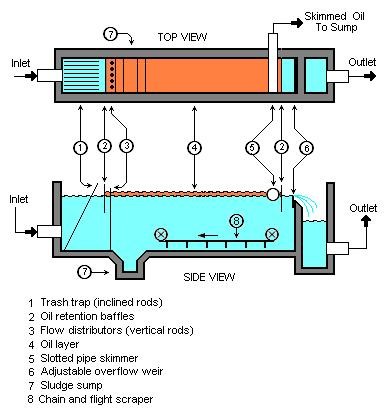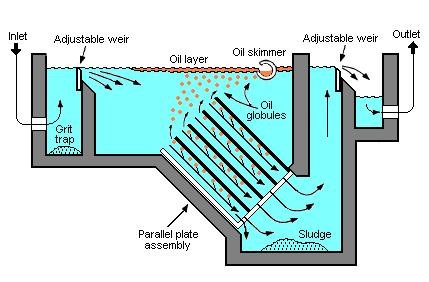Oil & Grease Trap
These are simple tanks with inlet & outlet baffle arrangement. The tanks are designed to give enough residence time to enable removal of free oil & grease & other floating matter, scum etc. A detention time between 10 min to 60 min is provided in which time the oil & grease rises up & is skimmed off.
API Oil Separator
The API separator is a gravity separation device designed by using Stokes Law to define the rise velocity of oil droplets based on their density and size. The design of the separator is based on the specific gravity difference between the oil and the wastewater. Based on that design criterion, most of the suspended solids will settle to the bottom of the separator as a sediment layer, the oil will rise to top of the separator. The wastewater will be the middle layer between the oil on top and the solids on the bottom.
The oil layer is skimmed off and subsequently disposed of, and the bottom sediment layer is usually removed by a chain and flight scraper and a sludge pump. The water layer is sent to further treatment consisting usually of a dissolved air flotation (DAF) unit for further removal of any residual oil and then to some type of biological treatment unit for removal of undesirable dissolved chemical compounds.

TPI Oil Separator
Tilted plate separators are similar to API separators but they include tilted parallel plate pack (also known as parallel packs). The underside of each parallel plate provides more surface for suspended oil droplets to coalesce into l arger globules. Any solids slides down the topside of each parallel plate. Such separators still depend upon the specific gravity between the suspended oil and the water. However, the parallel plates enhance the degree of oil-water separation. The result is that a parallel plate separator requires significantly less space than a conventional API separator to achieve the same degree of separation.

All particles or droplets having a settling or flotation velocity Vs> Q (flow)/A (area) are fully intercepted. An enlarged separating surface can be achieved by placing various smaller planes on top of each other in the tank. If these planes are subsequently inclined in a tilted position, material separated between the plates is removed by the gravitational force. This is the principle on which the TPI corrugated plate pack is based. The planes in this plate pack have been constructed in the shape of corrugated plates. They promote both the coalescence of the intercepted oil particles and, at the same time, their transfer through the plate pack.
If settle-able material is present in the liquid, such material is collected and concentrated in the troughs of the corrugations so that it will slide down in the plate pack smoothly and easily. Very small separating diameters can be obtained in the TPI system, because the disturbing factors, such as eddies and turbulences, which adversely affect large conventional separating tanks, are eliminated in the TPI.
Advantages of the TPI system
- No moving parts
- High separation efficiency
- Compact construction gives great economy in space and foot print
- Low installation costs on site since units can be prefabricated
- Minimum maintenance and operation costs
- Uniformity in design guarantees quick delivery of unit and spares
- Short hydraulic retention time
- Continuous operation
- Insensitive to weather conditions and variations in temperature and water quality
- Resistant to shock and slug loads.
Typical Removal Rates
- Oil globules cut off diameter: 10 – 60 µm and larger
- Oil removal 50 –> 99%
- Residual 5 – 20 ppm slop oil
- TSS removal 80 –> 90%
Dissolved Air Floatation unit (DAF)
DAF is used as a separation technique where the flocs formed are very light and have tendency to float to the surface. Microscopically small air bubbles are produced by dissolving air under pressure in the recirculated clear water which is then mixed and released with the influent liquid containing particulate matter. The tiny bubbles with diameters are 30-80 microns will be attached to the flocs which are then transported to the top quickly where they are removed as surface sludge by a special skimmer arrangement.
Cavity Air Floatation Unit
Microbubbles are injected in wastewater in a baffled aeration section. This is a compact self-contained unit with minimal space requirement. CAF may be broadly divided into four sections as follows:
- Aerator: It draws ambient air and injects it microbubbles into wastewater without letting it dissolve. These bubbles attach to particles and move it in a upward direction towards the water surface.
- Flotation (Clarification) area: This area is utilized for separation of suspended solids from wastewater. The tiny bubbles are instrumental in moving the colloids, fats, greases and oils to the surface.
- Solids Discharge Chamber: The floated solids are removed by a scraper into a discharge channel. Further these solids are collected in a container and taken for disposal.
- Clarified Effluent Channel: The water after the clarification unit is channelled into a tank with level controls. Adjustable weirs may be used to maintain the level and flow of water in this section.
Rotating Oil drum skimmer
The “Rotating Oleophilic Drum Skimmer” is a continuous and selective device for the recovery of decanted hydrocarbons on the surface of oily water decantation tanks. It is designed for use on pre-deoilers, on API tanks and on any surface of water where a film of oil is present.
Working Principles
The rotating oleophilic drum skimmer consists of a cylinder covered with an oleophilic skin
This device, continually rotating on the surface of the water, picks up the hydrocarbons and any oleophilic compounds but without picking up water. The hydrocarbons and oleophilic compounds are then recovered using a fixed position scraper.
The originality of this process is that the amount of water remaining in the recovered oil is very low thus making it unnecessary to dehydrate the residue through heating or centrifugation.

Advantages
- As the recovered oil contains practically no water residue, storage and dehydration costs are reduced
- The continuous recovery of hydrocarbons makes it possible to reduce loss through evaporation, often high when dealing with volatile compounds.
- The disappearance of smells near the de-oiling tanks is noticeable.
- As supernatant oils are continually recovered, the quality of the water coming from the decantation tank is drastically improved. Finishing treatment is thus easier due to a greatly reduced inflow of oil.
- From a safety point of view, the recovery of hydrocarbons with reduced evaporation of volatile compounds makes the de-oiling operation inert as far as the risk of fire is concerned.
Applications
- Oil production plant
- Refinery
- Chemical industry
- Mechanical Industry
- Automobile
- Floating drum for industry
- Marine drum for oil spill STOPOL
- Steel making



